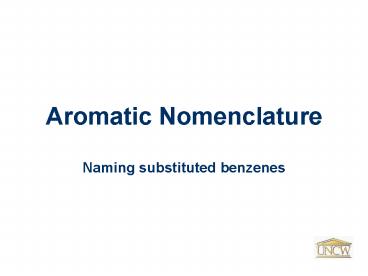Aromatic Nomenclature - PowerPoint PPT Presentation
1 / 18
Title:
Aromatic Nomenclature
Description:
Aromatic Nomenclature. Naming substituted benzenes. Monosubstituted Benzenes. Monosubstituted aromatics are named using -benzene as the parent name preceded ... – PowerPoint PPT presentation
Number of Views:161
Avg rating:3.0/5.0
Title: Aromatic Nomenclature
1
Aromatic Nomenclature
- Naming substituted benzenes
2
Monosubstituted Benzenes
- Monosubstituted aromatics are named using
-benzene as the parent name preceded
by the substituent name (as a prefix all one
word)
fluorobenzene nitrobenzene
ethylbenzene
3
Alkyl-substituted Benzenes
- Alkyl substituted benzenes are named according
to the length of the carbon chain of the
alkyl group. - With six carbons or fewer in the alkyl chain,
they are named as alkylbenzene. - e.g., propylbenzene
4
Alkyl-substituted Benzenes
- With more than six carbons in the alkyl chain,
they are named as a phenylalkane, where the
benzene ring is named as a substituent (phenyl)
on the alkane chain - e.g., 4-phenylnonane
4-phenylnonane
5
Common Names of Subs. Benzenes
- There are a number of nonsystematic (common)
names commonly used for certain monosubstituted
benzenes - These common names should be memorized.
- These common names are used as base names when
naming di- or trisubstituted aromatic compounds
derived from them.
6
Common Names of Subs. Benzenes
7
The Benzyl Group
- The benzyl group is a common name for a methyl
substituted benzene (toluene) having substitution
for one of the hydrogens on the methyl group. - e.g., benzylbromide
the benzyl group benzylbromide
8
Disubstituted Benzenes
- Disubstituted benzenes can be named in one of two
ways. Each method describes the relative
positions of the two groups on the benzene ring. - Systematic numbering of the aromatic ring.
- Using the prefixes ortho-, meta-, or para-.
- The common names for monosubstituted benzenes are
used as parent (base) names for disubstituted
aromatics. - When numbering the ring carbons, carbon 1 is
always carbon bearing a substituent. If one of
the substituents changes the base name, the
carbon bearing that group is carbon 1.
9
Disubstituted Benzenes
- ortho- o- 1,2-disubstituted
- (two groups on adjacent carbons on the ring)
10
Disubstituted Benzenes
- meta- m- 1,3-disubstituted
- (two groups having one unsubstituted carbon
between them)
11
Disubstituted Benzenes
- para- p- 1,4-disubstituted
- (two groups on opposite sides of the ring)
12
Disubstituted Benzenes
- When one of the substituents changes the base
name, o-, m-, and p- can be used to indicate the
position of the other substituent.
4
1
3
2
2
1
p-bromoaniline or 4-bromoaniline
o-chlorophenol or 2-chlorophenol
13
Common Names of Disubs. Benzenes
- There are a few nonsystematic (common) names for
disubstituted benzenes that you should be
familiar with
14
Polysubstituted Benzenes
- Polysubstituted benzenes are named by numbering
the position of each substituent on the ring
(with more than two substituents, numbering must
be used rather than o-, m-, and p-.) - The numbering is carried out to give the
substituents the lowest possible numbers. - Carbon 1 is always a carbon bearing a
substituent. - For rings with common names, the carbon bearing
the substituent responsible for the common name
is always carbon 1.
15
Polysubstituted Benzenes
- The ring is numbered in a direction to encounter
the next substituent with the lowest number. - The substitutents are listed in alphabetical
order when writing the name. - Common names of the monosubstituted benzenes are
used as parent names for polysubstituted
aromatics.
16
Polysubstituted Benzenes
4
1
3
2
3
2
5
1
4
4-bromo-2-ethyl-1-nitrobenzene
5-bromo-2-chlorophenol
17
Polysubstituted Benzenes
2
1
1
2
3
6
3
4
6
5
5
4
2-bromo-6-chloro-4-nitrotoluene
1-bromo-3-chloro-2-ethyl-5-nitrobenzene
18
Polycyclic Aromatic Hydrocarbons (PAH)
Metabolic byproducts of benzo a pyrene react
with DNA to form adducts, leading to
carcinogenesis (cancer).































